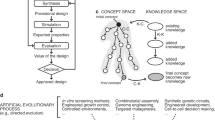Abstract
Many molecules can rotate internally around one or more of their bonds so that during a full 360° rotation, they will change between unstable and relatively stable conformations. Ethane is the textbook example of a molecule exhibiting such behaviour: as one of its two methyl (CH3) groups rotates once around the central carbon–carbon bond, the molecule will alternate three times between an unstable eclipsed conformation and the preferred staggered conformation. This structural preference is usually attributed to steric effects1,2,3,4,5,6,7; that is, while ethane rotates towards an eclipsed structure, the electrons in C–H bonds on the different C atoms are drawing closer to each other and therefore experience increased repulsion, introducing a rotation barrier that destabilizes the eclipsed structure8,9. Stabilization of the staggered structure through rotation-induced weakening of the central C–C bond10 and hyperconjugation11,12 has been considered to be involved, but evaluation of the contributions of these effects to ethane's internal rotation barrier and conformational preference remains difficult13,14. Here we report a series of ethane structure optimizations, where successive removal of different interactions indicates that ethane's staggered conformation is the result of preferential stabilization through hyperconjugation. Removal of hyperconjugation interactions yields the eclipsed structure as the preferred conformation, whereas repulsive forces, either present or absent, have no influence on the preference for a staggered conformation.
This is a preview of subscription content, access via your institution
Access options
Subscribe to this journal
Receive 51 print issues and online access
$199.00 per year
only $3.90 per issue
Buy this article
- Purchase on Springer Link
- Instant access to full article PDF
Prices may be subject to local taxes which are calculated during checkout



Similar content being viewed by others
References
Jones, M. Jr Organic Chemistry (W. W. Norton & Company, New York, 2000).
Carey, F. A. Organic Chemistry (McGraw Hill, New York, 2000).
McMurry, J. Organic Chemistry (Brooks/Cole, Thomson Learning, New York, 1999).
Vollhardt, K. P. C. & Schore, N. E. Organic Chemistry: Structure and Function (W. H. Freeman and Company, New York, 1998).
March, J. Advanced Organic Chemistry (John Wiley & Sons, New York, 1992).
Loudon, G. M. Organic Chemistry (Benjamin/Cummings, Menlo Park, California, 1988).
Carey, F. A. & Sundberg, R. J. Advanced Organic Chemistry (Kluwer Academic/Plenum, New York, 2000).
Sovers, O. J., Kern, C. W., Pitzer, R. M. & Karplus, M. Bond-function analysis of rotational barriers: ethane. J. Chem. Phys. 49, 2592–2599 (1968).
Christiansen, P. A. & Palke, W. E. A study of the ethane internal rotation barrier. Chem. Phys. Lett. 31, 462–466 (1975).
Bader, R. F. W., Cheeseman, J. R., Laidig, K. E., Wiberg, K. B. & Breneman, C. Origin of rotation and inversion barriers. J. Am. Chem. Soc. 112, 6530–6536 (1990).
Brunck, T. K. & Weinhold, F. Quantum mechanical studies on the origin of barriers to internal rotation about single bonds. J. Am. Chem. Soc. 101, 1700–1709 (1979).
Reed, A. E. & Weinhold, F. Natural bond orbital analysis of internal rotation barriers and related phenomena. Isr. J. Chem. 31, 277–285 (1991).
Wiberg, K. B. & Rablen, P. R. Comparison of atomic charges derived via different procedures. J. Comp. Chem. 14, 1504–1518 (1993).
Reed, A. E. & Weinhold, F. Some remarks on the C-H bond dipole moment. J. Chem. Phys. 84, 2428–2430 (1986).
Badenhoop, J. K. & Weinhold, F. Natural steric analysis of internal rotation barriers. Int. J. Quant. Chem. 72, 269–280 (1999).
Goodman, L., Gu, H. & Pophristic, V. Flexing analysis of ethane internal rotation energetics. J. Chem. Phys. 110, 4268–4275 (1999).
Weinhold, F. in The Encyclopedia of Computational Chemistry (ed. Schleyer, P. v. R.) 1792–1811 (John Wiley & Sons, Chichester, 1998).
Weisskopf, V. F. Of atoms, mountains, and stars: a study in qualitative physics. Science 187, 605–612 (1975).
Badenhoop, J. K. & Weinhold, F. Natural bond orbital analysis of steric interactions. J. Chem. Phys. 107, 5406–5421 (1997).
Glendening, E. D., Badenhoop, J. K., Reed, A. E., Carpenter, J. E. & Weinhold, F. NBO 4.0 (Theoretical Chemistry Institute, University of Wisconsin, Madison, 1996).
Frisch, M. J. et al. Gaussian 98 (Gaussian, Pittsburgh, Pennsylvania, 1998).
Acknowledgements
We thank R. Sauers for comments. Support by the National Science Foundation is acknowledged.
Author information
Authors and Affiliations
Corresponding author
Rights and permissions
About this article
Cite this article
Pophristic, V., Goodman, L. Hyperconjugation not steric repulsion leads to the staggered structure of ethane. Nature 411, 565–568 (2001). https://doi.org/10.1038/35079036
Received:
Accepted:
Issue Date:
DOI: https://doi.org/10.1038/35079036
This article is cited by
-
Conformational energies of reference organic molecules: benchmarking of common efficient computational methods against coupled cluster theory
Journal of Computer-Aided Molecular Design (2023)
-
Automated iterative Csp3–C bond formation
Nature (2022)
-
Experimental and computational insights into the synthesis and characterization of a novel Schiff base ligand 2, 2′-[(1z, 14e)-2, 5, 8,11,14-pentaazapentadeca-1, 14-diene-diyl] diphenol
CSI Transactions on ICT (2021)
-
Conformational changes for porphyrinoid derivatives: an information-theoretic approach study
Theoretical Chemistry Accounts (2021)
-
Ab initio and NBO studies of methyl internal rotation in 1-methyl-2(1H)-quinolinone: effect of aromatic substitution to 1-methyl-2(1H)-pyridone
Journal of Molecular Modeling (2020)
Comments
By submitting a comment you agree to abide by our Terms and Community Guidelines. If you find something abusive or that does not comply with our terms or guidelines please flag it as inappropriate.



